 |
||
|
Ios: One Day Begins as Another Day Ends |
||
|
It is reputed to lure more youthful revellers than any other Greek island, but there are other attractions to be uncovered too JONATHAN CARR |
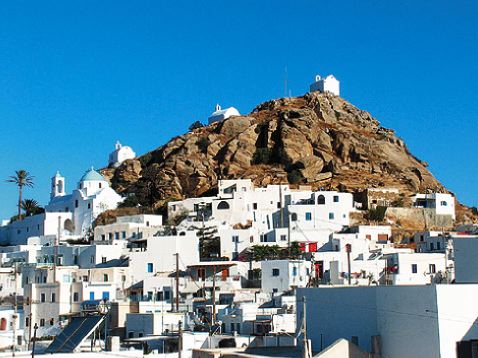 Panagia Gremiotissa's Church is perched on the highest rock of Ios' Hora |
|
| an exchange of nods, banter and 'kalimeras' with the men in the kafeneio. Some of the men have flat caps, some have baseball caps, some have walking sticks, most have sunglasses but they all - yes, these old men have a fashion sense too- they all have worry beads with dazzlingly bright yellow tassels. Nothing that goes on around here escapes them, and nothing escapes their comment. This is their spot, these are their chairs, this is what they do in the morning and that is the way it has been, if not always, at least for decades. Behind them, on a signboard above the doorway of the kafeneio, is a name in a wavy script - Ios Blue - and posted on a board in the window is a bill of fare. You can buy here, it tells you in a kind of English, such specialities as kamikaze, B52, blow job, brain, jelly shot, hot shot, slipery niple... Over on the other side of the square two pretty girls in short skirts sit on a doorstep in a patch of sun, elbows on their knees, subdued, pulling hunks out of a loaf of fresh bread. Soon they will go to bed. They are still drunk. And so does one day end as another begins on the Cycladic island of Ios. |
||
In the Municipality's office, they are touchy about Ios' reputation. The sleazy days of drugs and sleeping out on beaches? Is that what you mean? (No, I didn't) Come on! That was more than twenty years ago! Now you can't get a room on the island for less than 30 euros a night. And we have lots of big hotels. And we have many older people visiting. Just look out there now, look around on the streets. You'll see them everywhere (True - in daylight hours). And there have been significant improvements, in the quality of services for tourists and the quality of life for islanders. The water supply system has been sorted out. A new hospital has been |
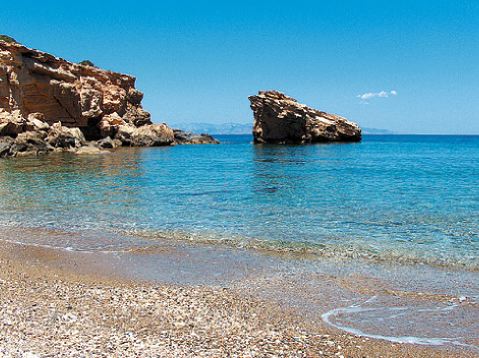 The sandy beach beneath 'Homer's tomb' |
|
| built. And there are cultural attractions like the archaeological museum, the ancient Skarkos site, shows at the (ten-year-old) Odysseus Elytis theatre. And you will soon be able to take a tarmac road to Homer's tomb at Plakotos. (Oh, please no....) And anyway, don't all islands attract young people? Look, we don't want to exclude anyone just because they don't have as much money as... Yes, they are a bit touchy. And in many ways they are right to be. Ios is more than their anodyne catchphrase for it, "the island of Homer and Dream..." - whatever that really means - just as it is more than all the cheap-shot clubs in Hora. Even so, the municipality boasts in its publicity booklet that Ios is "considered to be one of the three international meeting places for young people and that is not accidental. Tens of thousands of young people visit Ios every summer for its unique entertainment. Numerous bars covering all choices in music will satisfy every taste." In July and August, the town's Hora excels at being the wildest and noisiest Cycladic party capital. Outside those months, it can be a more mixed affair. |
||
Uncertainty remains about Ios' earliest days, though we know the Phoenicians were probably here first and that they were followed by the Ionians towards the end of the 2nd millennium BC. The island's name, according to different theories, may derive from the Phoenician word ion meaning stones, it might have been called Ios after the Ionians themselves or it may come from the Ia trees that were said to be all over the island at one time. There is exciting work, though, going on at the moment which may provide enlightenment, if not about the island's name, at least about a flourishing settlement which existed here in the Early Cycladic II period, from 2700 to 2400BC. The Skarkos |
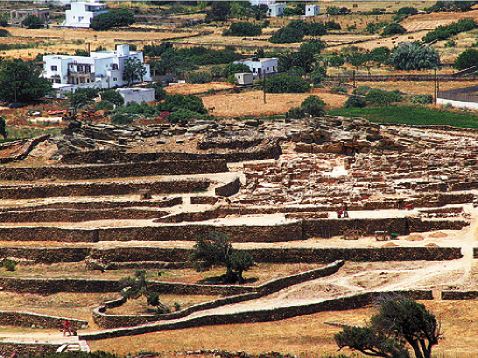 The Skarkos site has provided finds which demonstrate the former inhabitants' building and pottery skills |
|
| site, directly opposite the island of Sikinos along the west coast, occupies a hilltop area of 1.1 hectares and it has already provided finds which demonstrate the inhabitants' building and pottery skills and indicate the extent of their trade with other islands - there is obsidian, for example, from Milos. This work began in 1986 and much of what has been found so far is displayed in the small but impressive archaeological museum. Visits to Skarkos itself require special permission at the moment, but trips round the site are planned for the future. Good news. |
||
|
References to Ios in Hellenistic times are skimpy (though we know it was a member of the Athenian Alliance) and it is not until AD1207 that the island's story reappears in record books when it became part of the newly-created Duchy of Naxos. But of most interest today is the role played by the Venetian Markos Crispos who took control in 1397 and fortified the town, building high defensive walls to protect it from pirate raids. If you walk up to the Hora from the port on the old mule path, parts of the walls are still visible, so you can get a feel for how formidable they might have seemed to an invasion party. |
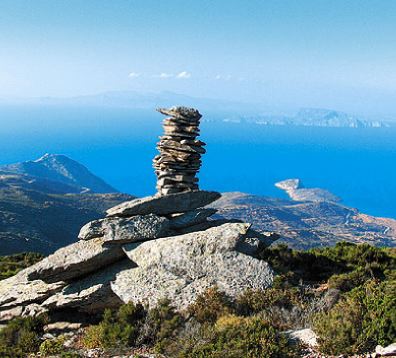 Chimney-shaped rock formation on the climb above the village of Psathi on the east coast |
|
| Interestingly, the pretty much deserted island was then colonised in 1579 by 280 Albanians by order of the Bey of the Cyclades. No doubt survivors of the Berber attack returned too. Hora and Homer The Hora is one of those enchanting whitewashed warrens full of steps and alleys, curtained doorways and small courtyards where red and white geraniums stand alongside pots of basil and miniature prickly pears. On the main thoroughfares there are the jewellery and souvenir shops (and, of course, the clubs) but overall this remains an evocative place where you can wander and get lost and be surprised - by a turning you hadn't noticed before, by the sudden glimpse of a windmill, by the charm of an old resident sitting on a wall in the shade, taking a rest on the way uphill, who strikes up a conversation; by the way sunlight spins off the cylindrical barrel of a church roof which at that moment and angle looks not dissimilar to one of the pithoi from the Early Cycladic II period in which liquids were stored. Ios, incidentally, is proud of its churches and claims (like Sifnos) to have the totemic number of 365 scattered across the island. Hora itself is full of them, ranging from the grand Evangelismos at its base to the more diminutive Panagia Gremiotissa Church perching on the highest rock in town. Its elevated position is ascribed to one of those restless icons which, dissatisfied with the church to which it had been assigned, climbed up there one night and demanded to be given a roof of its own. |
||
|
The island beyond Hora does not exactly vanish, that would give the wrong impression, but it does quite dramatically diffuse itself into sparsely inhabited valleys and rocky hillsides which in turn lead down to strings of sandy beaches. Some of the beaches are developed (Mylopotas, near Hora, is the prime example) but most are not. And the beaches, like Hora's clubs, are the main reason why people come to Ios. Tourism, of course, provides nearly all the island's employment. Not much agriculture goes on these days - there is some livestock, some barley, some bee-keeping (the hillsides have a good covering of thyme) and some cheese-making but that's about it. Only a handful of fishing boats lie in port. |
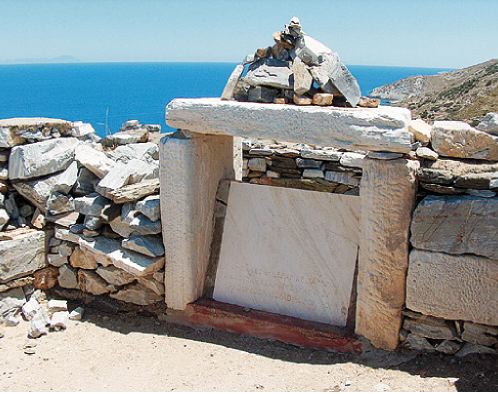 What the Municipality claims is 'Homer's tomb' at Plakotos |
|
|
"His grave exists in the area called Plakotos..," they state blithely, without qualification. He died on Ios "unable to solve the riddle fishermen in the area of Plakotos set for him". |
||
| More "evidence" of the Homeric presence is provided by the existence of six coins dating from the Hellenistic age which show Homer's name and head, and from a marble plaque found near the east coast village of Agia Theodoti which shows there is a calendar month named after the poet, the "Homereon". This plaque dates to the 3rd century AD. The tomb designated by the Municipality to be that of Homer is the most ornately preserved grave among a number of others rediscovered on a picturesque hill in a settlement that has largely disintegrated. The remains are believed to date from no earlier than the Byzantine period. No matter! A sheltered seating area and a paved path have been built to facilitate the pilgrimage to "Homer's" tomb. |
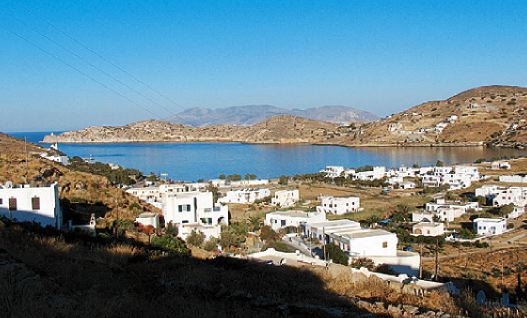 A view of Ios' port, Yialos |
|
|
Even if Homer existed, even if he did die on Ios 2,700 years ago, it is obviously sheer fancy to imagine that this spot is where his bones once lay. But this is the line the Municipality is pushing. And this is where they are taking their newest tarmac road. The tour buses will follow and fable will, in some minds at least, harden into history. Does it matter? Well, maybe it doesn't, not really. Maybe it is enough that visitors are reminded about The Iliad and The Odyssey when they come to Ios to lie on its beaches or wander its Hora or dance in its clubs. At 2am Plateia Spyridon Valetas, named after Greece's first minister of education post-1821, is a seething mass of international youth. Education, though, is not much on their minds just now. I am grabbed by the arm as I negotiate a way through. "You know what's amazing about this place? " No, tell me, I say. "Everyone's completely trashed." And so the cycle continues. A few hours later, one day will end as another begins. The flagstones will be hosed down, the kafeneio will be reoccupied by its familiars with their bright yellow worry beads and the young tourists will stagger off to bed. How to get there Fast boats from Piraeus often call in at Ios on their way to and from Santorini. Journey time is about 3 hours. Otherwise, there are the slower ferries which take about 8 hours, calling in at other islands on the way. See www.openseas.gr Where to stay At the top of Hora, Maria's Place - Faneromeni (22860-91327) offers clean rooms with fine sunset views. There are many other options - one just outside the village itself is Village Twins (22860-91155). Otherwise, Mylopotas Beach is full of hotels and rooms Where to eat The Nest in Hora offers good home-cooked food with friendly service, while the Lord Byron, tucked away in a small alley in Hora, offers a more exotic and experimental range Photos by Jonathan Carr |
||
|
|
||
(Posting Date 8 June 2007) HCS readers can view other excellent articles by this writer in the News & Issues and other sections of our extensive, permanent archives at the URL http://www.helleniccomserve.com./contents.html
All articles of Athens News appearing on HCS have been reprinted with permission. |
||
|
||
|
2000 © Hellenic Communication Service, L.L.C. All Rights Reserved. http://www.HellenicComServe.com |
||

